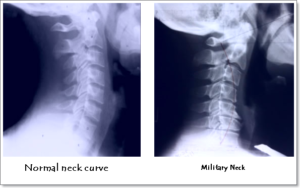Depending on the posture you are in, your neck normally has a gentle curve. A change in the anatomy of the neck where this curve is lost is generally referred to as a straight neck. When the neck curve direction reverses and is no longer straight, the condition is cervical kyphosis. These changes are usually not symptomatic and few patients will complain of pain. However, if a patient is diagnosed with the military neck syndrome, the changes of the cervical anatomy are chronic and pathological. In this case, the patient experiences symptoms relating to the underlying condition.
The condition is also called the Silicon Valley syndrome because many people in the Silicon Valley suffer from it.
Causes of military neck
Various causes can result in the loss of the normal neck curve.
Bad posture: Affects the normal configuration of the neck vertebrae which results in the loss of the neck curve.
Neck injury: Trauma from a neck injury may push the vertebrae of the neck out of position its normal curvature. The ligaments in the cervical spine can also tear or fracture and make the spinal cavity narrow. Causes of such injuries include a fall, contact sport or an auto accident.
Use of a thick pillow: Using a thick pillow under your neck while sleeping has similar consequences as those caused by trauma.
Spine surgery: Side effects of corrective surgeries such as laminectomy, a procedure to release the pressure on the spine, can work counteractively. Some medications also have the same effect. The term iatrogenic disorder is used describe these events.
Text neck: A condition that results from repeatedly bending the neck while using mobile devices.
Medical conditions
- Tumors, infection or systemic disease: cause the irritation or compression of the spinal cord by interfering with the ligaments found along it.
- Degenerative disc disease: there are soft discs between the bones of your spine that allow it to move and bend. This condition appears when over the years the discs thin and shift their position. The condition makes the neck and head to tilt forward eventually.
- Birth defects/congenital disorder: refer to cervical kyphosis that develops in the womb observed at birth or during adolescence. Imaging that is done before birth can also detect it. The spine grows abnormally leading to other developmental problems of the renal system, for example, kidneys and bladder deformities.
Symptoms Associated With Military Neck
The symptoms and severity of the conditions related to military neck depend on the underlying cause.
Pain and stiffness in the neck: when pain is experienced, the condition is deteriorating. In some patients, the pain can radiate to the shoulder and arms and even cause headaches. Other patients may not have pain but can develop it after the diagnosis. This is a demonstration of the mind’s power to create symptoms based on anticipating a condition to become symptomatic.
Cervical kyphosis has other symptoms like
- Limited movement ability of the neck
- Bowel issues
- Muscle weakness
- Impaired coordination
- Mild to severe deformity of the spine
- Hampered mobility
- Paralysis
Diagnosis
Often, the visual presentation and posture in military neck patients can be used to diagnose the condition.
Imaging studies can also be used to diagnose straight spine conditions like the military neck. They include x-ray, CT scan or MRI.
Treatment Of Military Neck
Although people tend to take pain medications to relieve the symptoms of military neck, it is not recommended. Drugs are known to affect the bacteria in the colon interfering with the digestive process. Surgery is also not a solution unless the condition has worsened to cervical kyphosis. Most people benefit from chiropractic interventions and physical therapy used together. Patients can also get relief from pain by using a neck brace.
Other ways Military Neck can be treated restoring the patient’s normal structure of the neck are:
Performing specific neck exercises
The exercises focus on strengthening the neck muscles to regain the normal curvature of the neck. Some of these exercises you can perform without a specialist’s help are:
- Try tucking your chin and bring the head forward gently in an effort to touch the chest. Next, bend back as far as you are able to. This exercise needs to be done at least five times in a day.
- Bring the left ear to the left shoulder as far as possible without rotating the neck. Maintain the position for at least 15 seconds and repeat the process for the right side.He exercise is effective if done for five times a day.
- Turn the neck to the as far as you are able to while attempting to touch your chin to the shoulders. Maintain the position for 15 seconds and do the same for the left side.
Neck traction
This is extending the neck slightly in order to correct the abnormality. It must be done by the physiotherapist to avoid injuring the neck muscles.
Neck pillow
These pillows are uniquely designed to help in cervical traction and relieve the Military Neck symptoms.
Yoga
Stretching your body with yoga poses helps you to lengthen the shoulders, neck and upper back. Consequently, the spinal vertebrae are readjusted helping in the correction of the cervical spine curvature.

